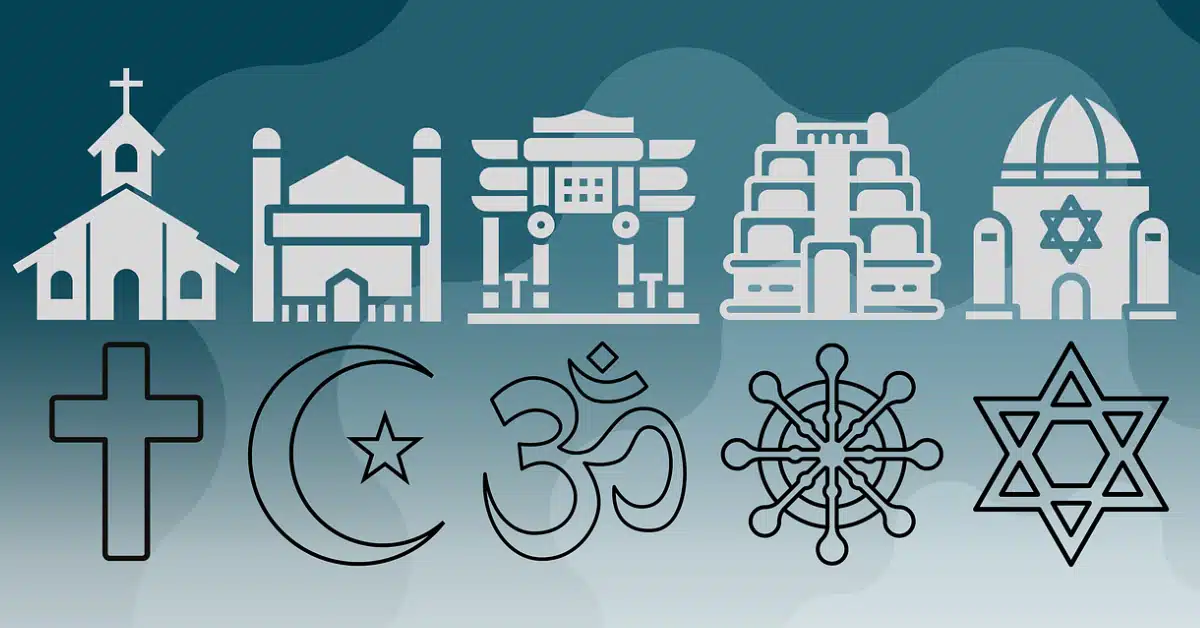Do you ever wonder why religious differences lead to conflict and violence? Have you ever thought about the impact of religious conflict on global politics?
If you’re interested in learning more about the history of religious conflict, the causes of religious conflict, and strategies for resolving religious conflict, then this blog post is for you.
This blog post will examine the diversity of religions in the world, the history of religious conflict, the causes of religious conflict, and the impact of religious conflict on global politics. It will also explore strategies for resolving religious conflicts, such as interfaith dialogue, education and awareness, and conflict resolution strategies.
It is not my intention to shed a dark shadow over religion, history has shown us how successful man has already accomplished that. My goal is to invite you into dialogue in hope we can bring about a more harmonious tolerance of our great diversity.
So, if you’re ready to learn more about the conflict of religious diversity and how we can promote peace and understanding between different religions, then read on!
I. Introduction
Definition of religion
Religion is a set of beliefs and practices related to the sacred and divine, which often includes an organization of followers. Religion is a cultural system of designated behaviors and practices, morals, worldviews, texts, sanctified places, prophecies, ethics, or organizations, that relate humanity to supernatural, transcendental, and spiritual elements.
Generally, religion is an organized collection of beliefs, cultural systems, and world views that relate humanity to the supernatural and transcendental. It often includes ritual practices, moral codes, and life view ethics, as well as personal and communal expressions of faith.
Overview of the diversity of religions in the world
The world is a diverse place when it comes to religion, with a vast array of belief systems, rituals, and practices. Some of the most common world religions include Christianity, Islam, Hinduism, Buddhism, Sikhism, Judaism, and Jainism.
In addition to these major religions, there are also countless smaller, less well-known religions, such as Baha’i, Shinto, Taoism, and Zoroastrianism. Even within these larger religions, there are many sects and sub-sects that offer different interpretations of scripture and beliefs.
These differences in religious beliefs often lead to conflicts between adherents of different faiths, as well as between religious and non-religious people.
II. History of Religious Conflicts
Examples of religious conflicts throughout history
Throughout history, religion has been a major source of conflict. For example, during the Crusades, Christian and Muslim forces fought over control of the Holy Land.
- In the 16th century, the Reformation saw Protestants and Catholics clash over the interpretation of scripture.
- In the 19th century, conflicts between Christians and Muslims in the Ottoman Empire sparked a series of wars.
- In the 20th century, the conflict between Hindus and Muslims in India and Pakistan was a major source of violence and displacement.
- More recently, the conflict between Christians and Muslims in the Middle East has been a major source of tension and violence.
All of these conflicts have been driven by deeply held religious beliefs and a desire to protect them.
Causes of religious conflicts
Religious conflicts arise from a variety of causes, including different interpretations of scripture, competition for resources, and the desire to spread one’s own faith. Religious differences can also lead to intolerance, fear, and hatred of those who practice different faiths.
Different interpretations of scripture can lead to disagreements over matters of faith and doctrine, which can lead to conflict.
In addition, competition for resources, such as land and water, can also lead to conflict between religious groups.
Finally, religious groups may seek to spread their beliefs and convert others, which can lead to conflict between adherents of different faiths. These conflicts can be driven by a variety of factors, but are often rooted in disagreements about religious beliefs and practices.
III. Current Religious Conflicts
Examples of current religious conflicts
Currently, there are a number of religious conflicts taking place around the world.
- In the Middle East, the ongoing conflict between Sunni and Shia Muslims has caused violence and displacement in countries such as Iraq, Syria, and Yemen.
- In Africa, the conflict between Muslims and Christians in Nigeria has led to attacks, kidnappings, and displacement.
- In Asia, the conflict between Buddhists and Muslims in Myanmar has caused violence and displacement of Rohingya Muslims.
- In India, the conflict between Hindus and Muslims has led to riots, attacks, and displacement.
- In Europe, the conflict between Christians and Muslims has led to a rise in far-right politics and anti-immigrant sentiment.
All of these conflicts are rooted in deeply held religious beliefs and a desire to protect them.
Impact of religious conflicts on global politics
Religious conflicts have had a major impact on global politics. These conflicts often lead to violence and displacement, and can have long-lasting effects on societies. They can also lead to increased tension between countries, and can spark geopolitical conflicts between states.
In addition, these conflicts can lead to an increase in far-right politics, and can fuel anti-immigrant sentiment. Religious conflicts have also been a major source of human rights violations, and have been used as a tool to oppress minority religious and ethnic groups.
Finally, religious conflicts can lead to a breakdown in social cohesion, and can threaten the stability of nations. As such, religious conflicts have had a major impact on global politics.
IV. Strategies for Resolving Religious Conflicts
Interfaith Dialogue
Interfaith dialogue is a key strategy for resolving religious conflicts.
Interfaith dialogue is a process in which members of different faith traditions come together to discuss their beliefs, practices, and differences in an effort to better understand one another.
This dialogue is based on mutual respect and understanding, and is aimed at building bridges between people of different faiths. Through dialogue, adherents of different faiths can learn to appreciate and respect one another’s beliefs and traditions.
Interfaith dialogue can also help to reduce tensions between religious groups, and can be a powerful tool for peace and reconciliation.
Education and awareness
Education and awareness are important strategies for resolving religious conflicts.
Educating people about different faiths, their beliefs and practices, can help to reduce misunderstandings and mistrust. It can also help to foster mutual respect and understanding between adherents of different faiths. Furthermore, education can help to dispel negative stereotypes and promote tolerance and acceptance of different religious beliefs and practices.
Awareness-raising campaigns can also be useful for educating people about the importance of religious tolerance and peace. Such campaigns can help to highlight the dangers of religious extremism and intolerance, and can help to foster dialogue and understanding between different religious groups.
Conflict resolution strategies
Conflict resolution strategies can be an effective way to resolve religious conflicts. These strategies involve a process of dialogue and negotiation between the different parties involved in the conflict.
By engaging in dialogue, parties can seek to understand each other’s perspectives, interests, and needs. This process can help to reduce tension and create an environment where both sides can reach a compromise.
Conflict resolution strategies can also be used to reach agreements on the distribution of resources, the protection of rights and freedoms, and the management of religious sites and symbols.
Conflict resolution strategies can help to foster understanding and trust between different religious groups, and can help to promote peace and reconciliation.
Conclusion
Summary of the points discussed In this blog post
- We explored the diversity of religions in the world and the conflicts such differences have created.
- We discussed examples of religious conflicts throughout history, as well as the current conflicts taking place around the world.
- We examined the causes of religious conflicts, and their impact on global politics.
- We also looked at strategies for resolving religious conflicts, such as interfaith dialogue, education and awareness, and conflict resolution strategies.
- Ultimately, it is important to promote peace and understanding between different religious groups in order to prevent and resolve conflicts.
Call to action to promote peace and understanding
It is up to all of us to promote peace and understanding between different religious groups in order to prevent and resolve conflicts.
We can do this by engaging in interfaith dialogue, educating ourselves and others about different faiths, and using conflict resolution strategies to reach agreements.
We must also strive to be respectful and tolerant of different religious beliefs and practices, and to recognize that we all share the same goal of peace and harmony. By doing so, we can help create a more peaceful and tolerant society for all.




